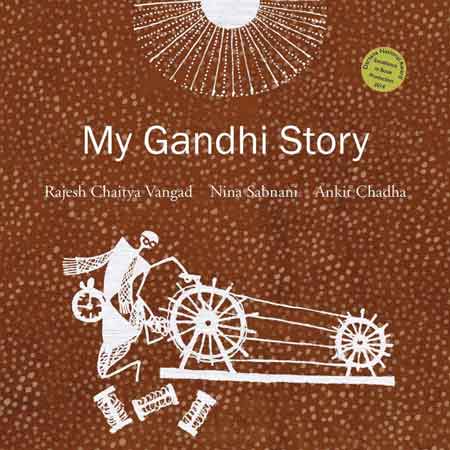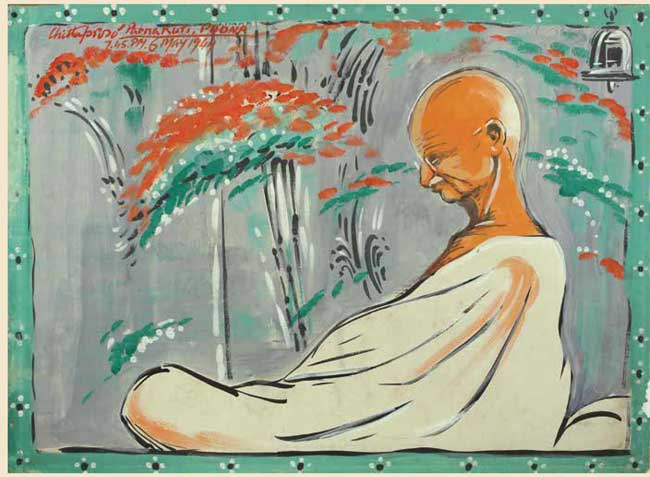
Gandhian social movement | Warli art and culture >>
My Gandhi Story | Preview or order this Tulika book here >>
Author : Nina Sabnani, Ankit Chadha
Illustrator : Rajesh Chaitya Vangad
Everyone has their own story of Gandhi — and in this book a Warli artist, a storyteller and an animation filmmaker come together in a unique collaboration to bring a very visual story of Gandhi to children. […]
Like the three creators behind the book, there are three voices that tell the story — of Rajesh the narrator, the questioning child, and Gandhiji or Bapu himself, all coming together to introduce young children to the great man called Mahatma Gandhi.
Source: My Gandhi Story
Address: https://www.tulikabooks.com/picture-books/my-gandhi-story-english.html?product_rewrite=my-gandhi-story-english
Date Visited: 14 January 2022
Illustrators of children’s books talk to ESTHER ELIAS about the challenges of bringing to life new narratives to grab young minds
[…] Niveditha Subramaniam, illustrator and editor at Tulika, adds that their recent books My Gandhi Story and Nabia now blend folk art, watercolour paintings and photographs to recreate Gandhi’s Gujarat days, and life in a Bombay chawl respectively. The last few years have also seen the mushrooming of digital art work demanded for apps, e-books and video editions of childrens’ stories, observes Senthil Kumar, founder of artists collective Sprog Studio.
“The publishing industry today is certainly looking towards stories from different regions, using diverse art forms, and our visual culture needs to evolve too without falling into easy stereotyping and generalisation,” says Srivi. There is a conscious effort to use the power of the image to break stereotypes, and this comes with increased respect for the child reader, says Niveditha. […]
Source: “Telling stories through pictures”, The Hindu (Metro Plus), August 13, 2014
Address: https://www.thehindu.com/todays-paper/tp-features/tp-metroplus/telling-stories-through-pictures/article6309920.ece
Date Visited: 14 January 2022
To view photos and read the full article, click here >>
[…] The seeds of the Wall Art Project, as this initiative is called, were sown in 2006 when a group of Japanese students visited Bihar’s Sujata village. They were studying to be teachers in Tokyo and were interested to know how the Indian schooling system worked. When they visited a primary school run by a non-profit, they found that there weren’t enough classrooms. On returning, the group raised funds to help the non-profit build more classrooms. […]
The ripples created by the project spread beyond Bihar. Rajesh Chaitya Vangad, an internationally acclaimed Warli artist from Maharashtra, visited Bihar in 2012 to participate in the festival. He invited Hamao to his village Ganjad, in Dahanu. Just like Sujata, the literacy rate there was less than 50% and school drop-out rates were high. The festival was organized in Ganjad in 2013 and 2014 in different government-run schools, with artists like Gauri Gill and Yusuke Aasai.
In Dahanu, during lean agriculture months, villagers leave to make bricks in towns. They withdraw the children from school and take them along. After this festival, parents realized that education is important. They are now leaving their kids at the residential facility in our school,” says 52-year-old Bapu Chavan, a science teacher at the Ashram School, where the festival was held in 2014. “Today, there are 400 students in the residential wing. Moreover, with each class adorned with a Warli, Gond or Japanese mural, the atmosphere has changed from the mundane to (something that is) vibrant and full of positivity.” […]
The Wall Art Project will return to the land where it all started—Bihar—at the end of this month. The New Holy Ganges School in Khagaria, Bihar, is usually a sleepy little place. But these days, the school is abuzz with excitement. Till recently, the words “graffiti”, “Warli” and “contemporary art” were alien to the students. No longer. Seven artists, such as Anpu Varkey from New Delhi, Ichiro Endo and Daisuke Kagawa from Japan, TONA from Hamburg, Dahanu-based Tushar and Mayur Vayeda are splashing the school walls with murals and graphic art. “Khagaria is the smallest district in Bihar. Superstition is rampant, and there is lack of health infrastructure. With the help of the Wall Art Project, we want to raise awareness about such issues,” says Abhishek Jalan, founder of the non-profit, iCanToo, which is supporting the project in the district.
Source: “Writings on the wall” by Avantika Bhuyan, Livemint, 21 November 2015
Address: https://www.livemint.com/Leisure/RLa4lrnw8GhsOUDhFdruDL/Writings-on-the-wall.html
Date Visited: 14 January 2022
“We shall first have to give up this hubris of considering tribes backward. Every tribe has a rich and living cultural tradition and we must respect them.” – Vice President M. Venkaiah Naidu on the constitutional obligation to respect the cultural traditions of India’s tribal communities

Gandhian social movement | Constitution | Adverse inclusion >>
“Air is free to all but if it is polluted it harms our health… Next comes water… From now on we must take up the effort to secure water. Councillors are servants of the people and we have a right to question them.” – Mohandas K. Gandhi, Ahmedabad address on 1 January 1918; quoted by his grandson, Gopalkrishna Gandhi, in “On another New Year’s Day: Mahatma Gandhi’s ‘khorak’ a 100 years ago” (The Hindu, 1 January 2018)
“The world has enough for everyone’s need but not for anyone’s greed.” – Mahatma Gandhi quoted by Medha Patkar and Baba Amte (Narmada Bachao Andolan)
Success stories that have made a world of difference for millions of schoolchildren and students:
Jointly creating storybooks in familiar languages for first-generation learners: Suchana, Pratham Books and StoryWeaver | More success stories >>
Up-to-date reports by Indian journalists and commentators
To search Indian periodicals, magazines, web portals and other sources safely, click here. To find an Indian PhD thesis on a particular tribal community, region and related issues, click here >>
Search tips
Combine the name of any particular state, language or region with that of any tribal (Adivasi) community.
Add keywords of special interest (music, poetry, dance just as health, sacred grove and biodiversity); learn about the rights of Scheduled Tribes such as the “Forest Rights Act” (FRA); and the United Nations “Declaration on the Rights of Indigenous Peoples”, “Universal Declaration of Human Rights”, “women’s rights”, or “children’s right to education”.
Ask a question that includes “tribal” or “Adivasi”, for instance: “Adivasi way of life better?” (or “tribal way of life worse?”)
Specify any particular issue or news item (biodiversity, bonded labour and human trafficking, climate change, ecology, economic development, ethnobotany, ethnomedicine, global warming, hunter-gatherers in a particular region or state, prevention of rural poverty, water access).
For official figures include “scheduled tribe ST” along with a union state or region: e.g. “Chhattisgarh ST community”, “Himalayan tribe”, “Scheduled tribe Tamil Nadu census”, “ST Kerala census”, “Particularly Vulnerable Tribal Group Jharkhand”, “PVTG Rajasthan”, “Adivasi ST Kerala”, “Adibasi ST West Bengal” etc.
In case the Google Custom Search window is not displayed here try the following: (1) toggle between “Reader” and regular viewing; (2) in your browser’s Security settings select “Enable JavaScript” | More tips >>
Note: hyperlinks and quotes are meant for fact-checking and information purposes only | Disclaimer >>